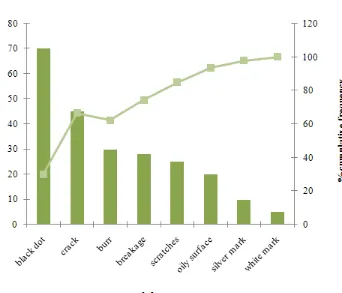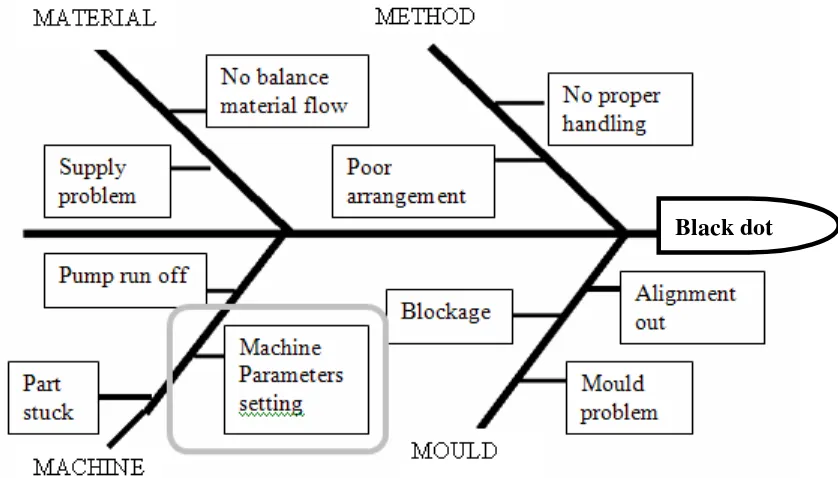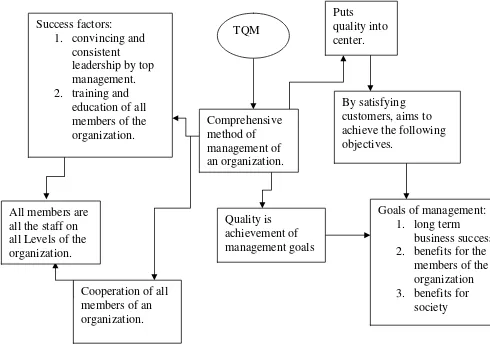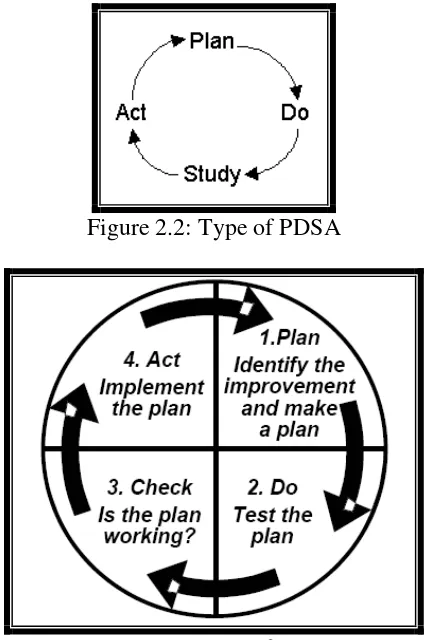UNIVERSITI TEKNIKAL MALAYSIA MELAKA
Quality Improvement Using
Classical Method Concept
in Injection Molding Manufacturing
Thesis submitted in accordance with the partial requirement of the Universiti Teknikal Malaysia Melaka for the
Bachelor of Manufacturing Engineering (Manufacturing Process)
By
Khairul Anuar Bin Mohd Nor
(B050410055)
i
UTeM Library (Pind.1/2007)
Quality Improvement Using Classical Method Concept in Injection Molding Manufacturing
ii
DECLARATION
I hereby, declared this report entitled
“Quality Improvement Using Classical Method Concept
in Injection Molding Manufacturing”
is the results of my own research
except as cited in references.
Signature :
iii
APPROVAL
This PSM submitted to the senate of UTeM and has been as partial fulfillment of the requirements for the degree of Bachelor of Manufacturing Engineering (Manufacturing
Pocess). The member of the supervisory committee is as follow:
……… Mr. H. Haery IP Project Supervisor
iv
ABSTRACT
v
ABSTRAK
vi
DEDICATION
For my beloved family:
Mohd Nor Bin Musa
Nor Arpah Bt. Bahari
Mohamad Fadhil Bin Mohd Nor
Nur Aziemah Bt. Mohd Nor
Muhammad Afiq Bin Mohd Nor
For my adored friends:
vii
ACKNOWLEDGEMENT
In the Name of Allah The Most Gracious, Most Merciful,
First of all, thanks to Allah S.W.T. to give me chance and strength to accomplish
the research of my final year project.
Special thanks to Mr. H. Haery IP, lecturer of the Faculty of Manufacturing
Engineering, University Technical Malaysia, Melaka as being my supervisor for my final
year project 1 and 2. I also would like to thanks to Pn. Rohana Bt. Abdullah as being my
second supervisor for my final year project. I would like to express my greatest gratitude
to my both supervisor, for his valuable guidance and continuing support throughout the
entire course of my work.
Finally, last but not least, I would like to thank my family and friends for all the
viii
2.2 Definition of Total Quality Management……….……….7
2.2.1 The PDSA and PDCA………..………..…….9
2.2.2 The component of Total Quality Management ……….10
2.2.3 Three basic component in TQM………....…10
2.2.4 Why is it important...…...11
2.2.5 When to used it………..11
2.2.6 How to use it………...………...11
2.2.7Why TQM can fail...12
2.3 Plastic Injection Molding Machine………..……...13
2.3.1 Injection Unit………..14
ix
2.4.1.4 Ambient Temperature Control………...……22
2.4.2 Pressure………23
2.4.2.1 Initial Injection Pressure……….23
2.4.2.2 Holding Pressure (Secondary Pressure)………..23
2.4.2.3 Back Pressure………23
2.4.3 Times………...24
2.4.3.1 Gate Close Time……….24
2.4.3.2 Mold Close Time………25
2.4.3.3 Initial Injection Time………..25
2.4.3.4 Injection Hold Time………25
2.4.3.10 Mold Inspection Time………..26
2.4.4 Distance………..………26
2.4.4.1 Mould Close Distance………27
2.4.4.2 Injection Distance……….…..27
2.4.4.3 Injection Hold Distance……….…27
2.4.4.4 Cushion (Pad) Distance……….….27
2.4.4.5 Screw Return Distance………...28
2.4.4.6 Mould Open Distance………28
2.4.4.7 Ejection Distance………28
x
3.0 METHODOLOGY...31
3.1 Project methodology……….………...31
3.2 Problem statement ………..……….33
3.3 Objective and scope ………33
3.4 Literature study………33
3.5 Identify the Classical method……….…….……….………...33
3.6 Identify the parameter setting ……….34
3.7 Analyzed the result………..34
4.0 RESULTS AND DISCUSSION
………...………...
404.1 Data for each machine that will be optimize………. 40
4.2 Machine range…..………..42
4.3 The calculation to get the optimum range………..43
4.31 Parameter That Will Be Optimum for Machine E03………43
4.32 Parameter That Will Be Optimum for Machine E07………48
4.33 Parameter That Will Be Optimum for Machine E10………54
xi
5.0 CONCLUSION AND RECOMMENDATION………60
5.1 Conclusion………..60
5.2 Recommendation………..………..62
REFERENCES…………...……….………..63
xii
LIST OF FIGURE
1.1 Pareto diagram of rejection 3
1.2 Cause and effect diagram for possible causes of machine parameter using a selected methodology
4
2.1 Structure of TQM according to these definitions 8
2.2 Type of PDSA 9
2.3 Type of PDCA 9
2.4 Plastic Injection Molding Machine. 13 2.5 Injection Molding Machine Parts. 14
2.6 Safety Gate 16
2.7 Nozzle Guard 17
2.8 Main key switch 18
2.9 Emergency stop push-buttons 18
2.10 Main processing parameters 21
3.1 Project Methodology 32
3.2 Flow Chart of process Injection Molding 35
3.3 Ghantt chart 37
3.4 Show the ‘black dot’ affect 39
7.1 The graphic of the Nilai Plant layout 65 7.2 Sumitomo injection moulding machine 65
7.3 Remote controllers 66
xiii
LIST OF TABLES
2.1 Average Time for Cycle Activities 24 3.1 Parameters that will be optimized 34 4.1 Data of parameter setting for Machine E03 40 4.2 Data of reject value, output value and percentage of reject for Machine
E03
40
4.3 Data of parameter setting for Machine E07 41 4.4 Data of reject value, output value and percentage of reject for Machine
E07
41
4.5 Data of parameter setting for Machine E10 41 4.6 Data of reject value, output value and percentage of reject for Machine
E10
41
1
CHAPTER 1
INTRODUCTION
1.1 Project Background
Today quality has become the most important competitive strategic tools to develop products and services in supporting continuing success. Quality also should be designed and applied to give a clearly view or step for organization to follow enabling understanding and involvement of employees proceeding towards for their target.
As an organization, there have their own aim of business for their profitability. In an organization, there have a lot of thing that must be alert like considerable length of time, earning is achieved by pleasing customers with good products or services while keeping production cost at a minimum. Besides that, the technique and the quality tool that be used also have to be more attention or focus because to get the lower costs and productivity improvements.
If there have a competition increases and changes occur in the business world, we need to be more understanding about of quality. Quality concerns affect the entire organization in every competitive environment. From all of this environment situation, there is an increasing focus on quality throughout the world. By increased competition, companies have recognized the importance of quality system implementation in maintaining effectiveness for their organization or business.
2
According to Sashkin and Kiser (1993) TQM means that the organization’s culture is defined by, supports, the constant attainment of customer satisfaction through an integrated system of tools, techniques, and training. To success the total quality management, there have a lot of term that can improvement this quality like top management commitment because the management must be fully committed to total quality system, convinced about its utility, prepared to incur the cost. Beside that, it is necessary that all the employees of the company are fully involved and give their utmost co-operation. Quality management can not be achieved by the efforts of one or a few persons. It also needs the joint effort of all the employees and everyone has to work as a team.
Thus, the TQM also can be success if the organization concern about customer feedback and complaints for avoiding recurrence of problems and to build confidence. TQM incorporates the concepts of product quality, process control, quality assurance, and quality improvement. Some advise that customer satisfaction is the driving force behind quality improvement; other suggests quality management is achieved by internal productivity or cost improvement programs and still others consider. Besides TQM there are other quality system used to improve quality such as classical method.
This research mainly focused on classical method to identify the current problem or rejection criteria facing by the company. The “Classical Method” used because, it provides a quality improvement methodology that use to quantify variation. The factors is interest in the analysis is the holding pressure, holding time, velocity of injection, temperature of plasticizer, temperature of mold, cooling time and back pressure.
3
1.2 Problem Statement
Currently in Alps Electric Parts Production Department which produce Plastic product for Electronic Component especially Remote Control as main business facing many rejection problem. The main defect cause this rejection is Black dot on the appearance of the product. There are also some other causes that lead to rejection such as part breakage, scratches, oily surface, white mark, silver mark, parting burr and etc.
4 1.3 The Possible Causes of Machine
Based from the main problem, by using the cause and effect diagram, we can know the possible causes of the machine.
Figure 1.2: Cause and effect diagram for possible causes of machine parameter using a selected methodology
1.4Objectives
• To study the possible causes in identified methodology of black dot rejection using the cause and effect diagram, and setting parameter variances.
• Utilize PDCA project methodology to conduct experimental on the identified machine parameter.
• To come up with the optimum setting parameter of the machine production. • To suggest continues improvement efforts the company in the future.
5
1.5Scope Of Project
The scope of the study is limited to part production 30 tone assembly lines only and the analysis is focused on major defect only, design of experiments of using the Classical Method to analysis and reduce the defects of the black dot by control the an optimal parameter.
1.6Project Overview
Chapter 1 gives an introduction about the projects which are including objectives, scope, and background.
Chapter 2 presents the literature review on Quality, concepts of Total Quality Management (TQM), Traditional Method experiment and about injection molding parameter. It also presents some quality tools that incorporate with the study.
Chapter 3 describes the company background and the description of the methodology used in this project.
Chapter 4 presents the data analysis using Traditional Method methodology. In this chapter the collected data from the case Study Company was analyzed stage by stage. First, the analysis starts with Define stage, which is continued with Measurement stage and then followed by Analyze stage. After analyze the problem based on the data collected, and then we go to the Improve stage and culminate with Control stage.
6
CHAPTER 2
LITERATURE REVIEW
2.1 Introduction of quality
The word ‘quality’ has different meaning under different circumstances (Jain, 2001). Quality is the customers' perception of the value of the suppliers' work output. Quality is a momentary perception that occurs when something in our environment interacts with us, in the pre-intellectual awareness that comes before rational thought takes over and begins establishing order. Judgment of the resulting order is then reported as good or bad quality value.
There are two definitive types of "quality":
i. Quality of design ii. Quality of the process
Whether you are in discrete manufacturing, process manufacturing or a service related industry you have design issues of usability, comfort, and tolerance of durability beyond prescribe use and identity of "status" of design quality. The ability to live up to the "quality of design" is maintained by the "quality of the process". All your actions aimed at the translation, transformation and realization of customer expectations , converting them to requirements, both qualitatively and quantitatively and measuring your process performance during and after the realization of these expectations and requirements .
7
Quality control (QC) has a narrower focus than quality assurance. Quality control focuses on the process of producing the product or service with the intent of eliminating problems that might result in defects. According to the meaning of it, QC includes the operational techniques and the activities which sustain a quality of product or service that will satisfy given needs; also the use of such techniques and activities.
Quality management is the totality of functions involved in the determination and achievement of quality (includes quality assurance and quality control).
Conformance to Valid Requirements, where to be valid, the requirements must be proven (in advance by management) to:
1) be achievable in operation
2) meet the needs of the intended user
Its making this a universal, operational and easy-to-use definition for the quality for all outputs from any work activity or process.
2.2 Definition of Total Quality Management
TQM is defined as a Management method relying on the cooperation of all members of an organisation. A Management method that centers on Quality and on the long-term success of the organisation through the satisfaction of the Customers, as well as the benefit of all its members and society (Anonymous, 2007a).
What is Total?
Everyone in the organization is responsible for quality.
What is Quality?
8 What is Management?
Management is a cycle of planning, doing, studying, and acting. All processes undergo the same cycle of management. These processes may be any of the following molding of a plastic part, recording of accounting information. In a ledger, development of an engineering system for a company.
9
2.2.1 The PDSA and PDSA
The PDSA cycle can be used in any type of management to be it quality, manufacturing, marketing, engineering and the other else. Many people will recognize the PDSA cycle as a general management tool. It was originally developed by Walter Shewhart, (1956) (yes, the guy that developed the original control charts for SPC) as the PDCA (Plan-Do-Check-Act) cycle. Base to Dr. W. Edwards Deming, (1950) popularized this approach to management. He changed from the PDCA to the PDSA just prior to his death.
Management is often the key to TQM. Most everyone thus, total wants to do a good job thus, quality or customer service, but, often management gets in the way of a person doing a good job. This interference happens in many different ways from being an offensive bully to simply not paying enough attention to someone. But, however a manager does it, managers prevent people from taking pride in what they do (Moen, Nolan and Provost, 1999).
Figure 2.2: Type of PDSA
10
2.2.2 The components of Total Quality Management
Total Quality Management is made up of three components. These components must work in harmony for the precept of TQM to work.
2.2.3 Three basic component in TQM:
a. Trust is the first component is very simple:
All involved with a product, company, and system must inherently trust everyone else to do their job, without concern that the company will fail. An example of inherent trust occurs on a baseball team. When an opponent hits the ball, the defending team's players never question whether their teammates will do their best to cause the opponent to be "out." The same is true at work, everyone in an organization must believe that the rest of the organization is doing their best for their business.
b. Customer focus is the second component is equally simple:
The customer is not always going to be right. At times, the customer will come to a supplier and request something that is not possible. It is at those times that the supplier must, gently, teach the customer about why they cannot have what they want. The customer may not be right, but the customer must be treated with respect. Thus, for TQM to work, you must focus on the customer. That customer must always feel that they are the most important thing in the world to your company.
c. Process management is the final component is not as simple, but is very basic:



